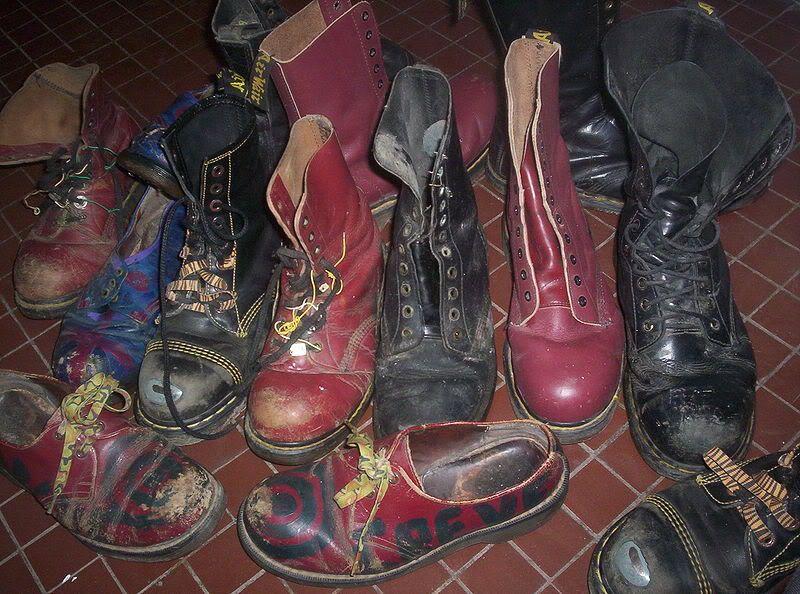Article published on Melbourne Street Fashion
Few can say at fifty years old that they look better than ever, are just as cool as ever, and are still adored as much as the day that they were conceived – unless of course you are Dr. Martens. This month the iconic footwear – worn by punks, mods, skinheads, soap stars and just about anyone with a statement to make – turned the big five-oh. Synonymous with music and freedom of expression, their rebellious grass-root history achieved them cult status from their onset. They have a patented sole, and are indeed a boot with a whole lot of soul.
A British icon, the boots actually originated in Germany. While on leave from the German army during WWII, Dr. Klaus Maertens hurt his ankle while skiing in the Bavarian Alps. In great pain, his military boots were too uncomfortable on his injured foot so he re-designed the shoes – adding soft leather and air-padded soles.
When the war ended, Maertens helped himself to some goods, looting leather from a cobblers shop and collecting discarded rubber from the Luftwaffe airfields. Maertens went into business with his old university friend, Dr. Herbert Funck, and the pair put Maertens’ boot design to production. The comfortable, cushioned, re-imagined boot was a huge hit with German housewives, with women over 40 accounting for 80 percent of their sales.
Due to their success they decided to expand internationally, taking the design to England. Having already heard of the combat boots’ innovative air-filled sole, British shoe manufacturer Griggs immediately bought the rights to the design. Griggs added the classic yellow stitching and the AirWair tag to the boot, and on 1 April 1960 the cherry, eight-eyelet “1460” (the date of their launch) were available in England. The tough, acid proof, boots became an immediate favourite with factory workers, postmen, builders and blue-collar workers in general.
Docs became a symbol of the working class: a big ‘fuck you’ to the elite. Wearing a pair was telling the world you were proud of your humble roots. Musicians appealing for working-class status wore Docs, with the ‘70s punk scene instantly adopting them. It was a resistant, tough boot - the perfect statement for an anti-establishment subculture.
Docs were torn, pinned and spray painted, each pair made individual so that wearing the “uniform” Docs didn’t mean conforming. Hence, today there are over 250 styles of Dr. Martens, making sure there is at least one pair to suit each personal taste.
A shoe born from fascist extremists, it’s little wonder that the threatening, steel capped boots later became a staple for the Brit skinhead neo-Nazi movement. Yet the rebellious youth ignored this negative association, with the mods, glam rockers, punks, goths, industrialists, hardcores, ska and grungers, all still drawn to the original, free-spirit, message that Docs embodied.
In the ‘90s the Seattle music scene shot Docs back into the spotlight. Worn with a flannel skirt, Docs (with the help of Nirvana) became synonymous with grunge. The ‘90s also saw the boots reach popular culture. Women wore them bare-legged with floral dresses in the style of Bridget Fonda in cult-classic film Singles. Brides wore patent white ones with their wedding dresses. The current re-emergence of ‘90s trends has seen Docs once again enter the mainstream.
Unfortunately, most Dr. Martens are now produced in China. But their “vintage” line, including the “1460” still come out of the Griggs factory in Wollaston, central England, still made by a few cobblers using the original technique and machines. Luckily, there is never a short supply of vintage Docs, and minding a few scuffs they are almost always as good as new.
The beauty of Docs is that they don’t belong to any one era or any one subculture. For the father remembering his rebellious youth they represent the ‘70s punk scene. For the woman in her late twenties they remind her of sitting in her room as a teenager, listening to Nirvana and saving her pennies for a pair of Docs so Kurt Cobain might just love her back. Or for the grandpa who boasts that he still has the first pair he bought in the ‘60s, muttering away that nowadays they don’t make shoes like the used to, they represent a time before cheap, mass produced, products.
Docs were never, and never will be, a fad because they have come to embody youth itself. They are a coming-of-age purchase; it seems everyone can remember the first pair they bought. They stand for rebellion, of finding freedom and not being dictated by mainstream culture, about understanding the importance of quality over passing trends. And like a youth who reaches adulthood, a life before Docs becomes a vague memory.
To celebrate their half-of-a-century milestone, Dr. Martens have released a 50th Anniversary Collection. In original colours cherry and black, the classic styles have been given a matte finish and gold eyelets. There is a limited in supply, with only 1,460 of the “1460” and 1,461 of the “1461” available. Opening Ceremony is selling the collection online – as well as the radically rad 'Darcie' heeled docs for lucky ladies.



Fabulous article. I am a Doc enthusiast. (Bummer about made in China though)
ReplyDeleteI bought my first docs as a sign of female rebellion and strength from a seedy shop in Broadway- Sydney. I was a late bloomer ready to set off to experience the world..... they made me feel fit for purpose!
I still have them ......not quite such a vibrant green , a bit dusty ......but they have stories to tell and still make me feel ..........comfortable , strong and reminiscent